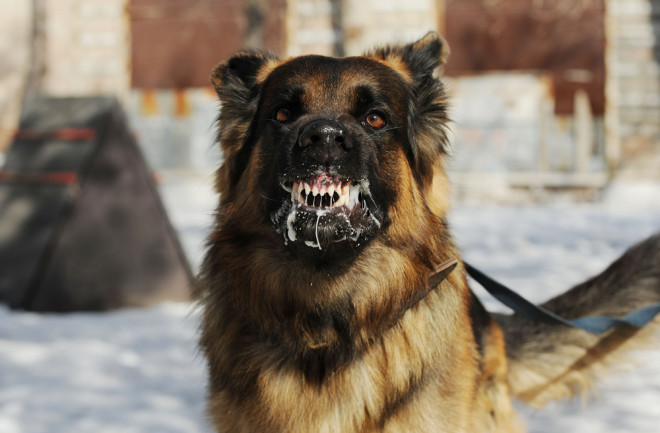Pretty much everyone knows what a phobia is: an extreme and unreasoning fear or aversion to something. While there are hundreds of known phobias, some of the most common include claustrophobia (fear of enclosed spaces), arachnophobia (fear of spiders), acrophobia (fear of heights) and aquaphobia (fear of water).
But if aquaphobia is an aversion to water, then what is hydrophobia? After all, it means fear of water, too. So which term is correct?
The answer, oddly enough, is both. But if you were forced to choose which affliction you’d rather have, trust us: You’d pick aquaphobia every time. Because if you were ever luckless enough to have hydrophobia, it would almost certainly mean that you’re about to die one of the most wretched deaths that a human can experience.
What Is Hydrophobia?
While hydrophobia and aquaphobia seem like terms that could be used interchangeably, aquaphobia is the preferred term for the psychological fear of water, which is a type of anxiety disorder. Hydrophobia, meanwhile, almost exclusively refers to a perceived physiological aversion to water as a result of infection by the rabies virus. In fact, hydrophobia is such a classic symptom of the disease that early medical experts considered the word synonymous with rabies.
Read More: Rabies, The Bestial Virus
And rabies, we probably don’t have to tell you, is supremely bad news. World health experts rank the virus as one of the deadliest diseases in history, right up there with such heavy hitters as Ebola, anthrax, plague and smallpox. While some form of rabies vaccine has been available since the 1880s, even today the virus still kills nearly 60,000 people worldwide. Human infections are extremely rare in the U.S., however — about 1 to 3 per year, with about 25 cases reported in the country over the last decade.
Why Does Rabies Cause Hydrophobia?
Human cases of rabies nearly always start with a bite from an infected animal. In the U.S., that typically comes from a bat, although any mammal can carry rabies, including raccoons, squirrels, coyotes and others. Historically, dogs have been a common carrier, as anyone who’s watched the Disney classic Old Yeller can tell you. Dogs are still a significant vector for infection around the world, but less so in countries like the U.S., where strict vaccination policies for domesticated animals have been in place for decades.
After a victim is infected, symptoms of rabies can take as little as a week or as long as a year to appear, as the virus incubates and makes its way to the brain and spinal cord. Once it reaches the central nervous system, though, symptoms will start to emerge. At first, they seem flu-like: fever, headache, general achy discomfort, perhaps some tingling or itchiness at the original site of the bite. From there, things only get worse, as patients begin to experience anxiety, confusion, erratic behavior, hallucinations and more. It’s around this time that the classic symptoms of hydrophobia begin to appear as well.
Read More: Protecting the Coolest Types of Bats in North America
Hydrophobia Symptoms
Once the virus has reached the central nervous system, it wreaks all kinds of havoc on the body. Muscles begin to twitch involuntarily, progressing to violent spasms and seizures. Hypersalivation (producing excessive spit) also happens at this stage, leading to the classic foaming-at-the-mouth symptom so commonly associated with rabies infections.
It’s at this point that sufferers begin to experience significant trouble swallowing. Trying to swallow so much as a sip of water — even thinking about trying to swallow it — is enough to trigger extremely painful muscle spasms. This is where the classic symptoms of hydrophobia are seen, although rabies victims aren’t really afraid of water; they’re afraid of the pain that comes with trying to swallow, even though they may be incredibly thirsty. This torturous existence can last for several exceedingly miserable days before the end comes.
Hydrophobia Treatment
Unfortunately, hydrophobia is a later symptom of rabies, occurring during what’s known as the excitation phase, which is followed by the inevitably fatal paralytic phase. Spasms stop as muscles become paralyzed. You won’t have hydrophobia anymore, but that is decidedly cold comfort at this stage. Because what happens next is that you fall into a coma. Then you die.
Rabies is 99.9 percent fatal — fewer than 20 cases of a human surviving a rabies infection have ever been reported, and many such reports have not been conclusively documented. In 2004, a young girl in the U.S. was considered the first documented rabies survivor in the world at that time, thanks to a Hail Mary protocol developed by a doctor in Wisconsin. While such medical miracles offer hope for the future, there is currently no approved treatment for rabies once you start showing the symptoms.
If you think you’ve been bitten by a rabid animal, your best bet to avoid hydrophobia — or any of the other awful symptoms of rabies — is to seek medical attention and get started on a course of vaccination shots within one to two days after exposure. The series of injections you’ll receive won’t be pleasant, but they will be far preferable to the alternative. So, get the shots. Then get a big glass of water — and be glad that you can still drink it.
Read More: Zoonotic Diseases That Have Been Transferred to Humans

